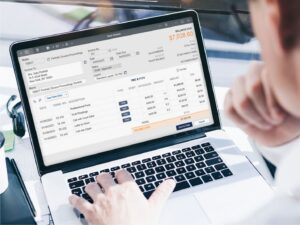Seeking financial convenience? Uncover the path to true financial clarity with these zen-like approaches to using accounting software. Embrace serenity as you effortlessly organize transactions, balance your books, and find harmony in your business finances. Find your center and let the software be your guiding light to a stress-free financial journey!
Remember, accounting software isn’t just a tool; it’s a gateway to financial empowerment and business success. Embrace these engaging steps, and let your accounting software become your trusted ally on the road to prosperity!
This piece walks you through all the information you need to be a pro at using accounting software.
Do you want to know the best accounting software to pick from? Try out any of these highly regarded ones:
- Zoho Books
- Tallyprime
- QuickBooks
- Xero
- FreshBooks
- QuickBooks Online
- Synder
- Sage
- Wave Accounting
- FreeAgent
Pause! Before you make a selection, consider the integration—does it have good interactions with other products or third-party apps? Integrations are important for accounting software because they: save time and reduce errors, streamline workflows and processes, increase productivity and efficiency; and enhance decision-making and insights. You don’t want to miss any of these amazing benefits. Do you? Sure, you don’t.
To use accounting software:
- Install And Setup The Accounting Software
- Familiarize Yourself With the Software’s Dashboard.
- Input Personal Financial Data
- Start Recording and Managing transaction
- Create Security Measures
- Manage your vendor and customer information in the software
- Utilize Reporting and Analytics
- Do Regular Software Updates:
- Set up user Permissions
- Take advantage of Training and Customer Support
Excited right? Let’s dive in!
>>> MORE: How to Find Free Invoicing Software
1. Install And Setup The Accounting Software
To use accounting software, install and set up the accounting software.
To do this, follow the following steps:
- Research and Choose the Right Software: Don’t be so quick to choose an accounting software. Before you dive in, take the time to research and choose the one that best suits your needs and budget. Consider factors like ease of use, scalability, pricing, and essential features like invoicing, expense tracking, tax management, and financial reporting.
- Installation and Setup: After selecting the software, go ahead and create your account. Follow the platform’s onboarding process, inputting accurate details and company information to ensure your data is organized and easily accessible. After installation, set up your account by entering essential information about your business, such as company name, address, and fiscal year.
- Chart of Accounts Setup: Make the software work for you by customizing your settings. Personalize your dashboard, set up your preferred currency and language, and define your tax rates. This step will streamline your workflow and ensure a seamless experience. The chart of accounts is the foundation of your accounting system. Customize it according to your business structure and needs. Set up accounts for assets, liabilities, equity, income, and expenses.
2. Familiarize Yourself With the Software's Dashboard.
To employ accounting software, familiarize yourself with the software’s dashboard. Here you see an overview of key financial metrics, such as account balances, income, expenses, and cash flow. This summary gives you an instant snapshot of your business’s financial health.
>>> PRO TIPS: How to Choose Billing Software
3. Input Personal Financial Data
To make use of accounting software, input your personal financial data. This entails that you:
- Input Initial Balances: If you’re transitioning from manual bookkeeping or another accounting system, consider importing your existing data to save time. This can include customer information, vendor records, and past financial transactions. Verify the imported data for accuracy before proceeding.
- Connect Bank and Payment Accounts: Link your bank accounts and payment processors to the accounting software. This enables automatic importing of transactions, saving you time on data entry.
4. Start Recording and Managing Transaction
To use accounting applications, start recording and managing transactions.
Start entering your business’s financial transactions into the software. This includes sales, purchases, expenses, payments, and any other money-related activities. Be sure to specify the appropriate accounts for each transaction. To manage your transactions, you need to set up and manage the following on your software:
Also, pay attention to the following financials:
- Bank Reconciliation: Regularly reconcile your bank and credit card accounts with the transactions recorded in the software. Match each transaction to its corresponding bank statement entry to ensure accuracy.
- Invoicing: Use the invoicing module to create and send invoices to your clients or customers. Customize invoices with your business logo and details. Monitor the status of invoices and track payments received.
- Expense Tracking: Record all business expenses, such as rent, utilities, supplies, and travel expenses, in the software. Categorize them correctly to get a clear picture of your business’s spending patterns.
- Payroll Management: If you have employees, use the software’s payroll feature to manage payroll calculations, tax deductions, and employee payments. Ensure that you comply with tax regulations and labor laws.
- Financial Reporting: Generate financial reports regularly, such as balance sheets, income statements, and cash flow statements. These reports provide valuable insights into your business’s financial performance.
- Budgeting and Forecasting: Utilize the software’s budgeting and forecasting tools to set financial goals and plan for the future. Compare actual results with your budget to analyze variances.
- Tax Preparation: Use accounting software to organize your financial data and streamline the tax preparation process. This simplifies tax filing and ensures accuracy in reporting.
5. Create Security Measures
To utilize accounting software, create security measures on your software to protect and back up your data.
Regularly back up your accounting data to safeguard against data loss. Ensure that the software’s security features are up-to-date and robust to protect sensitive financial information.
Data security is paramount. Regularly back up your accounting data either on the cloud or an external drive. This practice ensures you protect your data against loss in case of technical glitches or hardware failures.
6. Manage Your Vendor and Customer Information in the Software.
To use the accounting software, Manage your vendor and customer information in the software. This is simple! Keep track of contact details, payment terms, and transaction history to maintain healthy business relationships.
7. Utilize Reporting and Analytics
To use accounting Software, customize reports on the software. This requires that you customize and Tailor financial reports to meet your specific needs. Customize report formats, date ranges, and account selections to gain deeper insights into your business’s performance.
Make data-driven decisions with the help of robust reporting and analytics tools. Generate financial statements, profit and loss reports, cash flow analysis, and more. These insights offer a clear picture of your financial health and help you plan for the future.
8. Do Regular Software Updates:
To operate accounting software, do regular updates.
Data security is paramount. Regularly back up your accounting data either on the cloud or an external drive.
Be aware of the latest versions of the software and install necessary patches or updates promptly. This ensures that you benefit from new features and bug fixes.
>>> GET SMARTER: Invoicing Software: How It Works
9. Set up User Permissions
To work with accounting Software, set up user permissions. If you have multiple users accessing the accounting software, set appropriate user permissions. Restrict access to sensitive financial data based on each user’s role and responsibilities.
Setting up user permissions in your accounting software is crucial for data security and controlling access to financial information.
As an administrator, create user roles defining specific access levels. Assign users to appropriate roles based on their responsibilities, perform thorough tests to ensure proper access, and regularly review and update permissions as needed. Following data security best practices and maintaining backups will further safeguard your financial data.
10. Take advantage of Training and Customer Support
To use accounting software, take advantage of training resources and available customer support to improve your proficiency in using the software to its full potential.
Recap
To operate accounting software, install and configure the accounting programme, then become comfortable with the dashboard. After this, enter personal financial information, and start recording and managing transactions.
Now go ahead to establish security measures, manage vendor and customer data in the software, use reporting and analytics, perform routine software upgrades, configure user permissions, and benefit from training and customer support.













